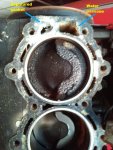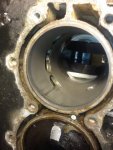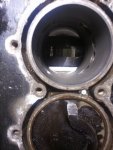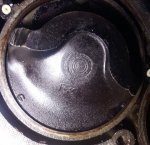HotTommy
Lieutenant Junior Grade
- Joined
- Mar 15, 2013
- Messages
- 1,025
I recently purchased a 1993 Force by Mercury 150 HP two cycle outboard engine. it was not running and was partially disassembled when I got it. The seller claimed it ran well until his last salt water outing when it began to miss on the way home. He pulled the head in an attempt to diagnose the problem and found the top piston badly pitted as in the photo that follows. He suspected detonation due to a lean carburetor. I'm not taking his word as I try to figure out what I'm working with.

My questions regard the likely cause of the piston damage and some head erosion I will describe. In the photo I have marked the "water passage" where water was intended to flow between the head and the block. Just to the left is an area I labeled "ruptured gasket." There is a water passage on the block side of the "ruptured gasket" area, but there is no corresponding passage on the head side. it appears that the gasket was intended to shield the head from the water flow in that area. But, the gasket is ruptured and a hole as wide as the rupture and up to 1/16" deep has been eroded into the aluminum head. The eroded hole had gotten close enough to the cylinder to make me suspect water was able to find its way past the gasket into the cylinder. If that were the case, would that be a likely cause for the piston damage?
i took the head to a good machine shop to be resurfaced. Resurfacing reduced the width of the eroded hole and it looks to me that there is enough space around the cylinder for a good head gasket seal. However, a small amount of the eroded hole remains. I am concerned that the hole will allow the gasket to deform there and encourage water to once again rupture the gasket. So my next question is whether there is a suitable way to fill the small eroded hole just to provide the gasket a firm surface on which to rest?
My final question is more out of curiosity than anything else. I'm wondering if the exposed surface of the head gasket was supposed to be strong enough to stand up to the force of the hot water rushing by it. Somehow I don't find it surprising that a gasket would fail under these circumstances. Therefore, I'm wondering if my attempt to fix this is even worth the effort. So my question is, is this kind of gasket failure common or uncommon? Or am I completely misunderstanding what has happened. I welcome your insight and comments.

My questions regard the likely cause of the piston damage and some head erosion I will describe. In the photo I have marked the "water passage" where water was intended to flow between the head and the block. Just to the left is an area I labeled "ruptured gasket." There is a water passage on the block side of the "ruptured gasket" area, but there is no corresponding passage on the head side. it appears that the gasket was intended to shield the head from the water flow in that area. But, the gasket is ruptured and a hole as wide as the rupture and up to 1/16" deep has been eroded into the aluminum head. The eroded hole had gotten close enough to the cylinder to make me suspect water was able to find its way past the gasket into the cylinder. If that were the case, would that be a likely cause for the piston damage?
i took the head to a good machine shop to be resurfaced. Resurfacing reduced the width of the eroded hole and it looks to me that there is enough space around the cylinder for a good head gasket seal. However, a small amount of the eroded hole remains. I am concerned that the hole will allow the gasket to deform there and encourage water to once again rupture the gasket. So my next question is whether there is a suitable way to fill the small eroded hole just to provide the gasket a firm surface on which to rest?
My final question is more out of curiosity than anything else. I'm wondering if the exposed surface of the head gasket was supposed to be strong enough to stand up to the force of the hot water rushing by it. Somehow I don't find it surprising that a gasket would fail under these circumstances. Therefore, I'm wondering if my attempt to fix this is even worth the effort. So my question is, is this kind of gasket failure common or uncommon? Or am I completely misunderstanding what has happened. I welcome your insight and comments.























